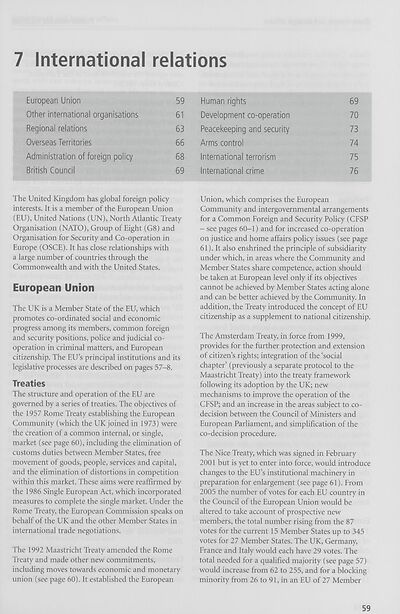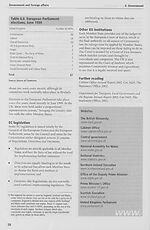Download files
Complete book:
Individual page:
Thumbnail gallery: Grid view | List view

7 International relations
European Union 59
Other international organisations 61
Regional relations 63
Overseas Territories 66
Administration of foreign policy 68
British Council 69
Human rights 69
Development co-operation 70
Peacekeeping and security 73
Arms control 74
International terrorism 75
International crime 76
The United Kingdom has global foreign policy
interests. It is a member of the European Union
(EU), United Nations (UN), North Atlantic Treaty
Organisation (NATO), Group of Eight (G8) and
Organisation for Security and Co-operation in
Europe (OSCE). It has close relationships with
a large number of countries through the
Commonwealth and with the United States.
European Union
The UK is a Member State of the EU, which
promotes co-ordinated social and economic
progress among its members, common foreign
and security positions, police and judicial co¬
operation in criminal matters, and European
citizenship. The EU’s principal institutions and its
legislative processes are described on pages 57-8.
Treaties
The structure and operation of the EU are
governed by a series of treaties. The objectives of
the 1957 Rome Treaty establishing the European
Community (which the UK joined in 1973) were
the creation of a common internal, or single,
market (see page 60), including the elimination of
customs duties between Member States, free
movement of goods, people, services and capital,
and the elimination of distortions in competition
within this market. These aims were reaffirmed by
the 1986 Single European Act, which incorporated
measures to complete the single market. Under the
Rome Treaty, the European Commission speaks on
behalf of the UK and the other Member States in
international trade negotiations.
The 1992 Maastricht Treaty amended the Rome
Treaty and made other new commitments,
including moves towards economic and monetary
union (see page 60). It established the European
Union, which comprises the European
Community and intergovernmental arrangements
for a Common Foreign and Security Policy (CFSP
- see pages 60-1) and for increased co-operation
on justice and home affairs policy issues (see page
61). It also enshrined the principle of subsidiarity
under which, in areas where the Community and
Member States share competence, action should
be taken at European level only if its objectives
cannot be achieved by Member States acting alone
and can be better achieved by the Community. In
addition, the Treaty introduced the concept of EU
citizenship as a supplement to national citizenship.
The Amsterdam Treaty, in force from 1999,
provides for the further protection and extension
of citizen’s rights; integration of the ‘social
chapter’ (previously a separate protocol to the
Maastricht Treaty) into the treaty framework
following its adoption by the UK; new
mechanisms to improve the operation of the
CFSP; and an increase in the areas subject to co¬
decision between the Council of Ministers and
European Parliament, and simplification of the
co-decision procedure.
The Nice Treaty, which was signed in February
2001 but is yet to enter into force, would introduce
changes to the EU’s institutional machinery in
preparation for enlargement (see page 61). From
2005 the number of votes for each EU country in
the Council of the European Union would be
altered to take account of prospective new
members, the total number rising from the 87
votes for the current 15 Member States up to 345
votes for 27 Member States. The UK, Germany,
France and Italy would each have 29 votes. The
total needed for a qualified majority (see page 57)
would increase from 62 to 255, and for a blocking
minority from 26 to 91, in an EU of 27 Member
59
European Union 59
Other international organisations 61
Regional relations 63
Overseas Territories 66
Administration of foreign policy 68
British Council 69
Human rights 69
Development co-operation 70
Peacekeeping and security 73
Arms control 74
International terrorism 75
International crime 76
The United Kingdom has global foreign policy
interests. It is a member of the European Union
(EU), United Nations (UN), North Atlantic Treaty
Organisation (NATO), Group of Eight (G8) and
Organisation for Security and Co-operation in
Europe (OSCE). It has close relationships with
a large number of countries through the
Commonwealth and with the United States.
European Union
The UK is a Member State of the EU, which
promotes co-ordinated social and economic
progress among its members, common foreign
and security positions, police and judicial co¬
operation in criminal matters, and European
citizenship. The EU’s principal institutions and its
legislative processes are described on pages 57-8.
Treaties
The structure and operation of the EU are
governed by a series of treaties. The objectives of
the 1957 Rome Treaty establishing the European
Community (which the UK joined in 1973) were
the creation of a common internal, or single,
market (see page 60), including the elimination of
customs duties between Member States, free
movement of goods, people, services and capital,
and the elimination of distortions in competition
within this market. These aims were reaffirmed by
the 1986 Single European Act, which incorporated
measures to complete the single market. Under the
Rome Treaty, the European Commission speaks on
behalf of the UK and the other Member States in
international trade negotiations.
The 1992 Maastricht Treaty amended the Rome
Treaty and made other new commitments,
including moves towards economic and monetary
union (see page 60). It established the European
Union, which comprises the European
Community and intergovernmental arrangements
for a Common Foreign and Security Policy (CFSP
- see pages 60-1) and for increased co-operation
on justice and home affairs policy issues (see page
61). It also enshrined the principle of subsidiarity
under which, in areas where the Community and
Member States share competence, action should
be taken at European level only if its objectives
cannot be achieved by Member States acting alone
and can be better achieved by the Community. In
addition, the Treaty introduced the concept of EU
citizenship as a supplement to national citizenship.
The Amsterdam Treaty, in force from 1999,
provides for the further protection and extension
of citizen’s rights; integration of the ‘social
chapter’ (previously a separate protocol to the
Maastricht Treaty) into the treaty framework
following its adoption by the UK; new
mechanisms to improve the operation of the
CFSP; and an increase in the areas subject to co¬
decision between the Council of Ministers and
European Parliament, and simplification of the
co-decision procedure.
The Nice Treaty, which was signed in February
2001 but is yet to enter into force, would introduce
changes to the EU’s institutional machinery in
preparation for enlargement (see page 61). From
2005 the number of votes for each EU country in
the Council of the European Union would be
altered to take account of prospective new
members, the total number rising from the 87
votes for the current 15 Member States up to 345
votes for 27 Member States. The UK, Germany,
France and Italy would each have 29 votes. The
total needed for a qualified majority (see page 57)
would increase from 62 to 255, and for a blocking
minority from 26 to 91, in an EU of 27 Member
59
Set display mode to:
![]() Universal Viewer |
Universal Viewer | ![]() Mirador |
Large image | Transcription
Mirador |
Large image | Transcription
The item on this page appears courtesy of Office for National Statistics and may be re-used under the Open Government Licence for Public Sector Information.
| Britain and UK handbooks > UK: The official yearbook of the United Kingdom of Great Britain and Northern Ireland > 2003 > (81) |
|---|
| Permanent URL | https://digital.nls.uk/204924160 |
|---|
| Attribution and copyright: |
|
|---|---|
| Description | Three volumes of 'UK: The official yearbook of the United Kingdom of Great Britain and Northern Ireland', published annually by the Office of National Statistics from 2002-2005. |
|---|---|
| Shelfmark | GII.11 SER |
| Description | Three titles produced by the British Government from 1954-2005 describing 'how Britain worked'. They are: 'Britain: An official handbook' (1954-1998), 'Britain: The official yearbook of the United Kingdom' (1999-2001), and 'UK: The official yearbook of the United Kingdom of Great Britain and Northern Ireland' (2002-2005). These 50 reports provide an overview of Britain's economic, social and cultural affairs, its environment, international relations, and the systems of government. They give an impartial summary of government policies and initiatives, and explain how public services are organised. |
|---|---|
| Additional NLS resources: |
|

